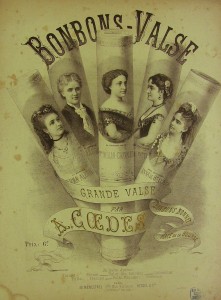Submitted by Kimberly White
“The most significant feature of the emergent popular music industry of the late 18th and early 19th centuries was the extent of its focus on the commodity form of sheet music.”[1]
What might a romance by Loïsa Puget, a lied by Franz Schubert, a mélodie by Victor Massé, a quadrille by Strauss Jr., a piano-vocal arrangement of grand opéra and a chanson by Edmond Lhuillier all have in common? They were all produced as popular sheet music, printed by the thousands and disseminated widely throughout 19th century France. But who purchased this music? In what kinds of venues might these pieces have been performed? What do the musical, textual, and iconographic characteristics reveal of the various sub-cultures represented by these heterogeneous works?
The McGill Music Library’s collection of 19th century French sheet music through its intermingling of “high” and “low” art as well as its broad representation of a wide spectrum of musical styles should be able to provide some of the answers. The collection contains well over 3,000 pieces ranging from the 1820s to the early 1900s. Comprising genres from the romance to the mélodie, as well as chansonnettes and chansons from the earliest cafés-concerts in the 1840s-50s to those pieces sung in the music-halls beginning in the 1860s and even in the cabarets artistiques in the 1880s, the collection offers scholars an exceptional opportunity to trace the origins and development of several of these popular music genres and sub-genres. With such a large sample of pieces determining the characteristics of the music, texts, subjects, performance styles and venues should vastly enhance understanding of popular forms of music in 19th century France.
 Salon culture—those semi-private, semi-public concert-gatherings given in the homes of the aristocracy, the rich bourgeoisie and professional musicians—is well represented by the large number of works in the collection by well-known romance and mélodie composers, such as Loïsa Puget, Amédée de Beauplan, Hippolyte Monpou, Louis Clapisson, Albert Grisar, Jacques Offenbach, Victor Massé, and J.B. Weckerlin. Often disparaged as “easy music,” these genres provide a fascinating glimpse into the cultural constructions of femininity and masculinity, social mores such as marriage, fidelity and inheritance as well as contemporary perceptions of the oriental “Other.” Those wishing to explore the ways music engages with social and political upheaval, might turn to the chansons and chansonnettes performed in the cafés-concerts, in music-halls and in the cabarets artistiques. In this repertoire, one can find some of the patriotic music composed in response to France’s humiliating defeat after the Franco-Prussian conflict of 1870-71, as well as examples of the chansons réalistes made popular by the singer Aristide Bruant (1851-1925), who sang of the plight of the working classes and the gritty reality of Parisian street life. Finally, there are a host of genres like the scène comique, performed by singing actors from Parisian boulevard theatres, that have received little—if any—scholarly attention.
Salon culture—those semi-private, semi-public concert-gatherings given in the homes of the aristocracy, the rich bourgeoisie and professional musicians—is well represented by the large number of works in the collection by well-known romance and mélodie composers, such as Loïsa Puget, Amédée de Beauplan, Hippolyte Monpou, Louis Clapisson, Albert Grisar, Jacques Offenbach, Victor Massé, and J.B. Weckerlin. Often disparaged as “easy music,” these genres provide a fascinating glimpse into the cultural constructions of femininity and masculinity, social mores such as marriage, fidelity and inheritance as well as contemporary perceptions of the oriental “Other.” Those wishing to explore the ways music engages with social and political upheaval, might turn to the chansons and chansonnettes performed in the cafés-concerts, in music-halls and in the cabarets artistiques. In this repertoire, one can find some of the patriotic music composed in response to France’s humiliating defeat after the Franco-Prussian conflict of 1870-71, as well as examples of the chansons réalistes made popular by the singer Aristide Bruant (1851-1925), who sang of the plight of the working classes and the gritty reality of Parisian street life. Finally, there are a host of genres like the scène comique, performed by singing actors from Parisian boulevard theatres, that have received little—if any—scholarly attention.
Overall, this sheet music collection promises to open up new avenues of research on the social and cultural “work” of 19th century sheet music as well as reveal issues of genre, performing contexts, and the various actors involved in the creation and dissemination of the music (performers, composers, librettists, publishing houses, music-hall and café-concert owners, etc.).
As a recent PhD graduate in musicology at McGill, my job is to evaluate the collection, collaborate with the library staff to develop a system for cataloging the pieces and to write research articles on the collection. After only three weeks of digging, the music of interest to me has rapidly grown in number to the hundreds. From my initial survey, I’ve decided to channel my research interests to two areas. The first examines how the sheet music industry capitalized on the celebrity of popular opera stars for marketing purposes and the ways singers, in turn, used popular song as promotional tools and to fashion their public image. I will be presenting a paper on this topic at the Canadian University Music Society Conference in Victoria, B.C., in June 2013. My second research topic will focus on changing perceptions towards women’s work throughout the 19th century, as revealed by a marked shift in tone in the text, music and iconography of sheet music produced after 1850.
Please stay tuned for more information on this exciting collection.
Kimberly White
[1] Richard Middleton and Peter Manuel, “Popular music,” Grove Music Online, Oxford Music Online (Oxford University Press, accessed February 28, 2013).

